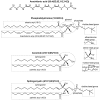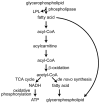Metabolomic Insights into Human Arboviral Infections: Dengue, Chikungunya, and Zika Viruses
- PMID: 30845653
- PMCID: PMC6466193
- DOI: 10.3390/v11030225
Metabolomic Insights into Human Arboviral Infections: Dengue, Chikungunya, and Zika Viruses
Abstract
The global burden of arboviral diseases and the limited success in controlling them calls for innovative methods to understand arbovirus infections. Metabolomics has been applied to detect alterations in host physiology during infection. This approach relies on mass spectrometry or nuclear magnetic resonance spectroscopy to evaluate how perturbations in biological systems alter metabolic pathways, allowing for differentiation of closely related conditions. Because viruses heavily depend on host resources and pathways, they present unique challenges for characterizing metabolic changes. Here, we review the literature on metabolomics of arboviruses and focus on the interpretation of identified molecular features. Metabolomics has revealed biomarkers that differentiate disease states and outcomes, and has shown similarities in metabolic alterations caused by different viruses (e.g., lipid metabolism). Researchers investigating such metabolomic alterations aim to better understand host⁻virus dynamics, identify diagnostically useful molecular features, discern perturbed pathways for therapeutics, and guide further biochemical research. This review focuses on lessons derived from metabolomics studies on samples from arbovirus-infected humans.
Keywords: alphavirus; arbovirus; flavivirus; lipid; metabolism; metabolomics.
Conflict of interest statement
The authors declare no conflicts of interest.
Figures



References
-
- van Oort P.M., de Bruin S., Weda H., Knobel H.H., Schultz M.J., Bos L.D., On Behalf of the MARS Consortium Exhaled breath metabolomics for the diagnosis of pneumonia in intubated and mechanically-ventilated intensive care unit (icu)-patients. Int. J. Mol. Sci. 2017;18:449. doi: 10.3390/ijms18020449. - DOI - PMC - PubMed
-
- Newborn Screening Laboratory Bulletin. U.S. Department of Health and Human Services, Centers for Disease Control and Prevention, National Center for Environmental Health, Division of Laboratory Sciences; Atlanta, GA, USA: 2008.
Publication types
MeSH terms
LinkOut - more resources
Full Text Sources

